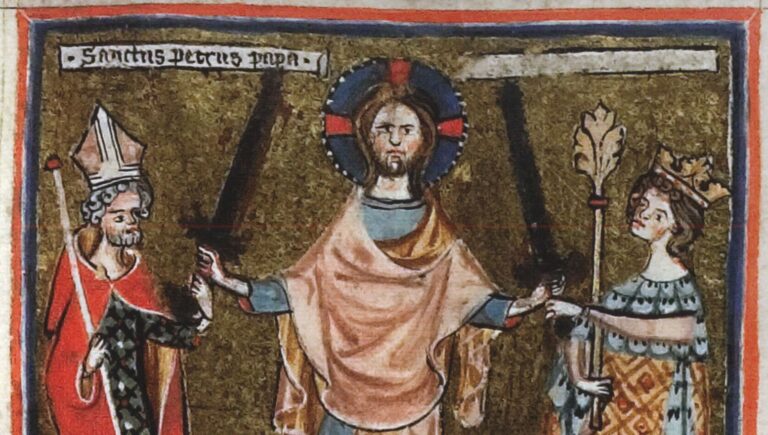
Biblical Demons in Modern Healthcare: The Book of Tobit and Health Policy
Nathan Perl, Devorah Shoenfeld, & Daniel Swartzman
The Healing of Tobit by Bernardo Strozzi (CC0 1.0).
There is ongoing discourse about the relationship between patient agency and external factors in health outcomes. It can be difficult to identify the multifaceted variables that answer the question of why one person becomes ill and not another. While individual action does certainly play a role, a body of research demonstrates the importance of one’s social condition and background on their health. Both are important, but it is difficult to balance these perspectives in health communications. A spiritual understanding may present a novel solution for reckoning with this dichotomy. Questions of human behavior and its relationship to illness have been discussed for millennia. We may find a novel method of conceptualizing responsibility and guilt by examining a relevant piece of biblical apocrypha, the Book of Tobit. Through this process this essay aims to present the value of an alternative view of the complex relationship between human agency and illness. The Book of Tobit is a widely circulated document that sought to inform health behaviors within the Second Temple period1. At its time, this text could be interpreted as a reference when it came to questions of illness. The clinicians of this period may have compared their patients to the central character of Sarah and her demonic affliction. May it be useful for today’s practitioners to imagine their patients and communities in a similar way?
Tobit as a Medical Reference in the 1st Century BCE
The primary mechanism by which Tobit, and contemporaneous texts, address the concept of illness is through the concept of demons. While many details are not medically accurate, the symptoms and ailments attributed to demons are certainly comparable to known illnesses (121). Thus, it has been thoroughly argued that demons in second temple theology represent an imperfect facsimile of germs.
The origin of demons in our natural world is explained in Genesis 6:1-4 as the result of the unsanctioned union between divine beings and humans (81). Enoch or The Book of Watchers significantly expands on the story told in Genesis 6 (154). Demons are described as innately nefarious and the cause of many afflictions such as illness and famine. In Hebrew biblical literature, the story of the watchers is cited as the origin of “natural evil.” Natural evil within this system of theology is entirely distinct from the concept of sin (26). Natural evil is the evil that simply exists in the world and causes many human ailments. It is through the context of demons that we see the physical manifestation of “natural evil” (4).
Where the Book of Watchers introduces the concept of demons and natural evil, it is expanded upon by the Book of Jubilees. This is a roughly contemporaneous text and was also widely circulated (161). The concept this text introduces is that of “demonic resistance.” Jubilees 10 describes an instance in which demonic forces have begun to “lead astray” the grandchildren of Noah. Noah prays to God to assist him in dispelling these nefarious forces. God complies but does so by empowering Noah, and therefore humanity, to resist and treat illness (98). This text presents a clear directive to resist demons and therefore treat illness. Simultaneously, however, it recognizes the power of these transmundane forces.2 Demons and the illness they caused were a natural piece of the world’s order. But also, actions undertaken by humans could dispel them. This dichotomy places the power for combatting demons in the hands of humans but also requires that they accept them as a condition of the world. Overall, these contextual writings establish that human agency can play a role in fighting demonic ailments but are not the sole determining factor (176).
The Book of Tobit is a relatively unusual text among related biblical literature; primarily it is concerned with the lives of normal individuals, not biblical heroes. The value of examining this text comes from its relationship to demonic practices, and ergo illness. Tobit is a prescriptive text; its goal is to argue for a specific worldview when it comes to illness. The primary theme of the text is the dichotomy of the transmundane and human agency.
It follows the story of Tobi, father of Tobiyyah, along with Sarah, daughter of Reuel. These two contrasting characters are essential to the narrative, both afflicted with their own ailments. Tobi is a pious and observant man; after being blinded he begs God for healing. Conversely, as recounted in the Book of Tobit, Sarah has been afflicted by the demon Asmodeus, who has killed seven men she was to be wed to. Sarah is a woman who has been surrounded by wickedness, she seeks penance and retribution from God for her ailment. However, she is depicted as a morally upright person. The dichotomy of these two characters seeks to illustrate the theological questions of the text: is illness the result of impiety and does morality play a role in healing? These questions are posed directly in Tobit 2:8.
“And Hannah answered and said to me, Where are they kindnesses and thine alms, which profit thee not in the day of thy trouble?”
The narrative is resolved similarly to that of Jubilees 10. Both Sarah and Tobi pray to God to cure their ailments, God in turn sends the angel Raphael to heal both of them (Tobit 3:4). The mechanism by which they are healed, however, is that of human agency. Tobiyyah is instructed by the angel Raphael to burn the innards of a fish to heal his wife to-be, Sarah, and his father, Tobi (89).
“The heart is good to smoke thereof before a man in whom is an evil spirit or the spirit of demons, and it will flee from him. And the gall is good for anointing therewith the eyes in which is whiteness, and they will be healed.” (Tobit 6:3)
While the source of this “medical” knowledge is divine, human agency is required for the treatment. This lesson is similar to the one in Jubilees 10 but expands upon it by emphasizing the concept of moral neutrality in illness. Demonic ailment was not only a morally neutral state, it was also one that could only be treated by human action, generally from another person (105). This position of illness in society places much importance on the treatment of the sick while simultaneously insulating them from moral judgement.
Disconnecting illness and treatment from the concept of sin is a very intentional feature of this text. By presenting an amoralistic perspective on treatment, it expands the moral imperative introduced in Jubilees 10. Illness is the result of natural forces and it is necessary to treat the sick regardless of their moral condition (129).
Applications of Tobit for Health Policy in the 21st Century CE
So, what value does Tobit present in discussions about health policy? Tobit can be categorized into the general body of literature that makes up halakha, often translated as “Jewish Law.” While this may not be the most accurate translation it provides an understanding as to the purpose of the text. In this context it is an imperative that the reader upholds these principles in their behavior towards the sick. Thus it encourages the empowerment of the individual and community in the face of illness. This can be translated into modern conceptions of self-efficacy in health behavior. By requiring the resistance of demonic forces, yet still recognizing their power and that of God, Tobit seeks to improve self-efficacy in the face of the harsh and multifaceted determinants of health. Self-efficacy has been described as one of the most important constructs in regulating one’s health behaviors (172). The power of this approach comes from the fact that much of our current health policy does not promote self-efficacy regardless of morality.
Bias in Obesity Treatment. For example, medical texts often perpetuate language that reinforces biases against overweight patients. The phrase “limited by body habitus” has gained particular attention for its moralistic judgment and dismissal of obese patients (48). This treatment of the patient differs from what is described in Tobit. Imagine Raphael and Tobiyyah as the clinicians, and Sarah as the patient. They do not withhold the available treatment for the reason of her demonic condition. It is illogical for the condition to be a barrier for treatment. So rather, she is expunged from culpability for her ailment and given the treatment she needs. This is regardless of said ailment’s wicked and demonic origins. If we consider obesity as the demon, are semaglutides synonymous with burning of the fish heart? They are an effective treatment in a case where many others, such as dieting, are not. They have the power to remove guilt from the treatment of obesity. Rather than telling the patient their ailment is caused by a lack of willpower, they present an amoralistic and physiological solution. From a policy perspective, only 13 states currently offer GLP-1s under Medicaid coverage. Further Medicare and most private health insurance plans do not cover these drugs. This dilemma is evidence of our misalignment in health policy. As these, often lifesaving drugs, are deemed as unnecessary and supplanting individual morality. This is the major distinction that the position represented in Tobit offers. It argues that there is an obligation to distribute the available treatment regardless of our moral judgement of the condition.
Hypertension and Guilt. The relationship between patient agency and external factors is very complex when considering patients with resistant hypertension. In treating resistant hypertension, there is significant evidence to suggest that both pharmacological and lifestyle interventions can be effective. Furthermore, it is evident that a combination of these approaches is ideal in treatment. At a policy level there is a need to make changes in both aspects. Conceptualizing responsibility free of guilt, as is done in Tobit, is an effective imperative for both interventions. From the pharmacological side, prices of antihypertensive drugs are high and only rising. Much like for semaglutides, Tobit presents an ethical framework that requires treatments such as this one to be accessible. At its core what the author of this text is saying, is that treatment without judgement is a key aspect of the patient’s rights. So it’s quite jarring that treatment inertia, a lack of action by the physician, is the norm for hypertension treatment. More than 75% of patients do not receive an escalation or change in medication. A common reason why is the issue of intrinsic guilt in this condition. When lifestyle interventions are proven effective there’s a societal perception that the diagnosis is the fault of the patient. Change in the policies of providers and the legal framework they exist in is necessary to combat this issue.
Smoking and Self-Control. Smoking, and addiction in general, is stigmatized as a lack of self-control. Such an approach places guilt on the patient and undermines their self-efficacy in quitting. Review of non-pharmacological smoking cessation programs demonstrates the inefficacy of this approach. A growing body of research suggests that predisposition to addiction may be genetic, or due to a number of other factors. So, similarly to the example of obesity, advances in medical science have revealed that a condition that has been believed to be behavioral in nature is largely physiological. Separating the notions of culpability and responsibility may be remarkably effective in this context. While it is the responsibility of the patient to quit, they should not be guilted for their addiction in the first place. An example of this approach being implemented can be found in smoking reduction campaigns in certain countries. These states have adopted ‘plain packaging’ of tobacco products instead of visually graphic imagery. This has proven to be more effective in reducing smoking rates than graphic warnings. The advantage of this approach is that it removes the moral charge behind graphic warnings. If we imagine the smoking population as Sarah, it would be ridiculous to scold her with images of her deceased husbands. Rather, it is effective to remove that baggage altogether and treat the patient with proven clinical solutions.
Conclusion
The worldview presented in the Book of Tobit, as it relates to health, contains values that should not be labeled as archaic and forgotten. Something has been lost in the systematization of health; this paper has argued that one such thing is the central dichotomy between patient agency and external forces. This dichotomy further leads to a removal of moral judgement from illness and treatment. While the terminology is vastly different, natural evil and demonic resistance compared to pathogens and treatment, the lessons taught in Tobit still hold weight. If the clinician or the policymaker imagines their patient or constituent as Sarah, it may have a major impact in creating an environment that empowers self-efficacy while still acknowledging the power of external determinants. In other words, we might encourage responsibility without culpability. Centralizing this idea in modern public health policy may increase positive outcomes and interactions for the community served.
Effective approaches and clinical best practice can be aligned with this idea. This can be evidenced by campaigns such as the plain packaging of cigarettes, use of semaglutides in obesity treatment, or interventions in hypertension. Beyond applying the idea of responsibility without culpability to existing best practice, it could be used as a cornerstone in future programs and studies. As a spiritual imperative for treatment and access, the lesson of Tobit could hold significant weight in our health policies. ♦

Nathan Perl is a student at Loyola University Chicago pursuing a Bachelor and Master of Public Health in Epidemiology. His areas of interests include the intersection of health policy with culture and spirituality

Devorah Schoenfeld, PhD is an Associate Professor at Loyola University Chicago. She has her doctorate from the Graduate Theological Union in Berkeley and an MA from the Hebrew University in Jerusalem.

Daniel Swartzman, JD is an Associate Professor of Healthcare administration and public health science at Loyola University Chicago. His research interests include the moral underpinnings of policy choices and advocacy for better policy.
Recommended Citation
Perl, Nathan, Shoenfeld, Devorah, & Swartzman, Daniel. “Biblical Demons in Modern Healthcare: The Book of Tobit and Health Policy.” Canopy Forum, July 25, 2025. https://canopyforum.org/2025/07/25/biblical-demons-in-modern-healthcare-the-book-of-tobit-and-health-policy/.
Recent Posts










